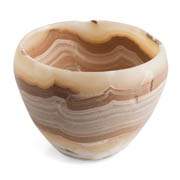Details
- Object type
bowl
- Place Associated
Egypt (place made); Ekhauhm (place found)
- Date
Early Dynastic, 1st -3rd Dynasties (circa 3000-2686 BC)
- Materials
travertine (Egyptian alabaster)
- Dimensions
overall: 113 mm x 152 mm x 152 mm 854 g
- Description
-
From the earliest times the ancient Egyptians were highly skilled in the shaping of very hard stones into elaborate vessels for funerary use. This bowl has been skilfully worked from a block of aragonite so that the colourful pattern formed by its internal laminations is seen to maximum effect. The stone would have been quarried during an expedition organised by the king into one of the remote deserts bordering the Nile Valley. It was then painstakingly hollowed out using a bow drill, cranked boring tool and abrasives of a stone harder than aragonite, to be formed into this exquisite shape.
Many stone vessels were produced specifically to be used as grave goods intended to be buried with their dead owner. In the tomb it showed the high social status of the deceased, and would have been used to hold offerings for him to enjoy in the afterlife.
During the late nineteenth and early twentieth centuries, excavations by European and American Egyptologists uncovered and removed vast quantities of grave goods from Egyptian cemeteries and tombs. These objects are now in museums and collections around the world today and this material has made a major contribution to our knowledge of the ancient Egyptians. Following the lead of Professor Sir Williams Flinders Petrie in the early 1900’s, excavators would often write a reference number on finds which would denote the original grave number of the object. In this case, the number 579 has been written on the base of the object. Unfortunately, it has not yet been possible to identify the site from which this originally came. Sir William Burrell recorded information given to him by the sellers of the objects he bought but sometimes misunderstandings and mis-spellings create difficulties. In this case, Burrell notes this was found in 1901 but the name of the site has been written as “Ekhauhm” but this is not the name of a place in Egypt. Significant variations in nomenclature and spelling exist between the modern names of places in Egypt and the names they were given by the European excavators and these names were often further garbled as they moved around the European antiquities market.
Provenance: Spink & Son, London; from where purchased by Sir William Burrell on 18 October 1948.
- Credit Line/Donor
Gifted by Sir William and Lady Burrell to the City of Glasgow, 1944
- Collection
Burrell Collection: Egyptian Items
- ID Number
13.87
- Location
In storage


